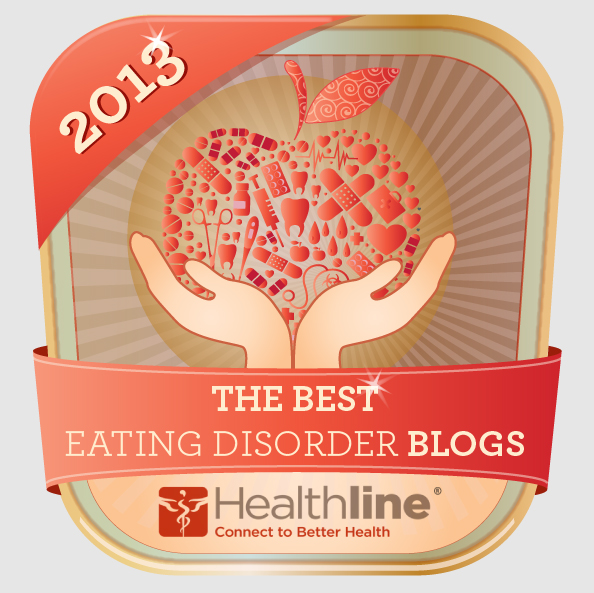
You'd Get Comfort From Seeing Bones
Battling eating disorders for over 10 years, young woman on the road to recovery.
The Expositor
Stacey Lake got solace from seeing her bones.
Reflected in a mirror, her ribs and collarbones protruded from a twig-like frame and her jutting hip bones, sharp beneath parchment-thin skin, were visible as easily from the back as from the front.
She could wrap her thumb and forefinger around her upper arm.
Still, she wasn't thin enough.
"You'd get comfort in seeing bones," said the now 27-year-old Brantford woman who has struggled with anorexia and bulimia for more than a decade.
Last summer, at her lowest weight, Stacey shrivelled to a skeletal 62 pounds on a five-foot-three-and-one-quarter- inch frame.
Then there was the binging.
Late at night, alone in the kitchen when everyone else was asleep, the starving Stacey would gorge herself in feeding frenzies.
She could consume two loaves of bread, a tub of margarine, three boxes of macaroni and cheese, 30 chocolate bars, two boxes of cookies, tubs of chicken wings and more -- all in a four-hour time span.
When full, she would head for the toilet to throw up. Then she'd feed again. Then purge again.
Read in full here.
-------------------
Impulsivity, Brain Abnormalities Connected With Bulimia Nervosa
Psychiatric Times
Women with bulimia nervosa (BN) respond more impulsively during psychological testing than do women without eating disorders, according to a recent article in Archives of General Psychiatry. Functional MRI showed differences in brain areas responsible for regulating behavior in women with and without BN.Rachel Marsh, PhD, and colleagues at Columbia University and the New York State Psychiatric Institute compared the results of the Simon Spatial Incompatibility task in 40 women (20 with and 20 without BN) who were undergoing functional MRI. Participants were asked to indicate on a response box the direction an arrow was pointing while wearing nonmagnetic goggles, regardless of where it appeared on the screen. The act of focusing on the arrow and ignoring the rest of the screen requires regulating behavior by fighting the tendency to respond automatically and resolving conflicting messages.
Patients with BN were more impulsive than controls: they responded more quickly and made more errors in the parts of the task that required self-regulatory control. Patients with the most severe symptoms made the most errors. The frontostriatal circuits in the left inferolateral prefrontal cortex, bilateral inferior frontal gyrus, lenticular and caudate nuclei, and anterior cingulate cortex were not activated in patients with BN as they were in the control group.
Read in full here.
----------------------
When Righteous Eating Crosses The Line
The Star Phoenix
Just as Jack Sprat would eat no fat and his wife would eat no lean, plenty of us are picky about what we eat.
There are those who simply don't like certain foods, and then there are those who impose strict dietary rules upon themselves because they believe it's good for them.
Some eat only organic foods, others only raw foods. There are those who refuse to eat animal products and those who eat macrobiotic diets, while others believe a diet high in meats and cheese -- but low on carbs -- is the best way to go.
And while many people manage these diets in a reasonably healthy way, there are others who become so obsessed with following their own rules that they put their health at risk.
When the fixation on healthy, pure or "righteous" eating becomes unhealthy, it's called orthorexia. The term was coined in 1997 by Colorado-based doctor, Steven Bratman, author of Health Food Junkies, a book that explores the condition.
Orthorexia is not recognized by the Diagnostic and Statistical Manual of Mental Disorders, but Dr. Laird Birmingham, a Vancouver-based eating disorder specialist, says it is a very real symptom or warning sign of an eating disorder, and sometimes accompanies anorexia.
"Basically, it refers to people that are very concerned -- to a tremendous degree -- about dieting and diet-related things," Birmingham said. "When it becomes a problem is when it affects your life, when it impacts your life -- when you would not go to work because of it, or would have to give up your date because of it."
Read in full here.
---------------------
Many Reasons Can Be Behind Eating Disorders
The Expositor
'An eating disorder is not a behaviour, it's an illness. An emotional illness," said Marilyn Clark, a registered nurse and counsellor with Eating Disorder Services of Brant.
Asking someone with anorexia to simply eat is "like asking someone not to be depressed," Clark said.
Eating disorders arise from a complicated mix of variables, not yet completely understood.
There may be a genetic component that increases the risk for some people to develop the disorder, Clark said.
Personality also comes into play, especially among people who tend to be perfectionists, she said.
Also susceptible are individuals involved in sports or activities where weight is an important factor or criteria, such as dancers, gymnasts and skaters.
Parents who are themselves obsessed with weight, and who constantly talk of dieting or going to the gym, can also influence youngsters' minds, Clark said.
"But underneath all eating disorders is emotional turmoil," she said.
An eating disorder begins with restricting food intake, but often evolves into "food fears" that result in the elimination of many foods altogether, she said.
"Soon they are living on nothing but salad and raw vegetables."
Individuals with eating disorders usually think "everyone else is OK but them," Clark said. However, very overweight people can be "frightening" to the anorexic who may fear the consequences of having "one tablespoon more" of food.
That is an example of the "extreme thinking" that eating disorders foster, she said.
Eating disorders usually surface among people in their early teens, although it can happen to people in their 30s and 40s, and is popping up among children as young as nine, she said.
Read in full here.
---------------------
Researchers 'Astonished' By Anorexia Death Rates
Psychiatric News
Anorexia nervosa is a very dangerous illness, not just over the short term but over the long term as well. Patients with this disorder need continuing, diligent follow-up care.
Anorexia nervosa, as psychiatrists know only too well, is a dangerous illness with a high rate of premature death.
But exactly how dangerous has become clearer—the result of a nationwide longitudinal study conducted by Swedish scientists.
The study team reported two major findings. The first was that compared with the general population, anorexia patients were at a heightened risk of death not only after hospitalization but many years later. The second was that their long-term risk of death came not just from anorexia but from a number of other causes as well.
The scientists were "astonished" by these findings, they wrote in their report published in the January British Journal of Psychiatry.
Thanks to the unique personal identification numbers assigned to all Swedish residents, and to the national cause-of-death records and national hospital-discharge records that Sweden maintains, these researchers were able to assess death from natural and unnatural causes in a nation-wide cohort of Swedish women with anorexia nervosa. The researchers studied the records of some 6,000 patients covering a 30-year period (1973 to 2003).
Out of the cohort studied, 265 died during the 30-year follow-up. The most frequent causes of death were suicide (responsible for 32 percent of the deaths), anorexia (19 percent of the deaths), and cancer (11 percent of the deaths). The remaining 38 percent of deaths were caused by other illnesses or by homicide. The average age at death for the 265 anorexia patients who died was 34.Read in full here.
---------------------
Dentists Often First To Spot Eating Disorders
Denistry.co.uk
Dentists are becoming the first line of defence when it comes to spotting eating disorders in patients.
The announcement comes just before National Eating Disorders Awareness Week (22-28 February).
The US Academy of General Dentistry raised awareness of the potential oral health problems that can be caused by eating disorders.
They suggest that, although parents may not recognise that their child is anorexic or bulimic, the oral signs of the disease are there when they take the child to a dentist.
Bad breath, sensitive teeth and eroded tooth enamel are just a few of the signs that dentists use to determine whether a patient suffers from an eating disorder.
Read in full here.
-------------------
What Men Can Do To Support Women With Eating Disorders
Jewish Exponent
For a guy who is astute or caring enough to notice that a woman's behavior might be signs of anorexia, bulimia or another eating disorder, it may only be the tip of the iceberg. This recognition might be lifesaving, but a solution with treatment and therapy will not occur overnight, according to Lauren Strobeck, program coordinator of the Eating Disorders Program at the Belmont Center for Comprehensive Treatment in Philadelphia. People in the midst of a serious eating disorder do not think clearly, she said. "Their sense of reality can be really sordid," she explained. "It's very hard to watch someone who doesn't understand how bad they are. It's heart-wrenching. Someone could be in a very, very precarious medical situation." Dealing with an eating disorder is a lot like dealing with someone suffering from drug or alcohol addiction, or a serious illness, according to Linda Smolak, a psychology professor and eating disorder expert from Kenyon College in Ohio. "This is a little like having cancer, you need to know this is a serious problem," she said. "I'm not trying to suggest that you go dumping her, but you can't change this overnight. You need to know that this is not something that goes away in two weeks." How to React Read in full here. ----------------- Anorexia Changes Bone Structure
Guys should look for warning signs. But after assessing the situation -- the woman's behavior in conjunction with analyzing the symptoms -- she said that open, nonjudgmental communication is important.
A new study presented at the annual meeting of the Radiological Society of North America (RSNA) showed that children and teenagers with even mild cases of anorexia, an eating disorder, exhibit abnormal bone structure.
Miriam A. Bredella, the lead author of the study and musculoskeletal radiologist at Massachusetts General Hospital (MGH) used high-resolution, flat-panel, volume computed tomography (VCT) to identify differences in bone structure between the anorexic patients and the healthy controls. Radiology published the study in its December issue.
VCT allows the examination of bone at high resolution with relatively low radiation exposure making it a suitable technique to evaluate bone structure in adolescent patients.
The subjects of the study were 10 girls, aged 13 to 18, with mild anorexia and 10 age-matched girls without the disorder. CT exam revealed structural differences between the groups. DXA which uses two x-ray beams of different energies to determine bone density, did not reveal structural differences.
“Adolescence is the most critical period for growth of bone mass, and the onset of anorexia interferes with that process,” Bredella, noted.
The researchers observed that though bone mineral density did not differ significantly between the patients and the control group, there were significant structural differences, indicating that changes in bone structure begin to occur in anorexic patients well before decreases in bone density.
“Impairment of bone development may alter bone structure permanently and increase the risk of fractures and osteoporosis in adult life.” She cautioned.
Anorexic patients suffer many health problems including bone loss. Normally, physicians rely on DXA to test bone mineral density (BMD) in adolescents with anorexia.
Read in full here.--------------------
Fashion Photographer Aims To Remodel Fashion World
Israel 21c
What is beauty? It's a question Israeli fashion photographer Adi Barkan has been wrestling with for seven years, ever since he launched a crusade to rid the fashion industry of its dirty little secret: presenting unhealthy body images that promote eating disorders among young women.
Yesterday, at a press conference in Tel Aviv, Barkan launched the next phase in his campaign: Simply U, a countrywide talent-scouting project to find the most promising healthy, well-balanced and normal-sized would-be models in Israel.
Together with Alon Gal, Israel's leading personal coach and a childhood friend, Barkan outlined the project's goals: Simply U will hold seven auditions around Israel and select 20 girls. For six weeks, they will be given training in grooming and modeling, as well as workshops in nutrition, sports and self-esteem. The idea, says Gal, is to turn them not just into fashion models, but into role models as well.
Simply U has ensured it will get lots of media exposure though Israel's Channel 2, which will follow the audition process, via a 24/7 Internet video channel and a social network that any young woman is free to join. There is a song, co-written by Barkan, which will be on Israel's IDF Radio play-list as of Sunday. Barkan also hopes to bring in opinion-leaders, both local and international, to speak on behalf of the project's goals.
Simply-U has four major sponsors: food company Strauss-Elite, cosmetics company L'Oreal; sports gear company New Balance and a contract is set to be signed this week with a leading fashion firm. "I needed four companies that would provide a way to living a healthy life," Barkan says, adding that he believes others will follow.
"Let's show them the way"
What Barkan is asking of the fashion industry is very difficult. He is asking the insiders, mavens and sophisticates to suspend cynicism and believe that they can change the world.
He has every reason to think he can do it. A 30-year industry veteran, Barkan started his crusade seven years ago, after his experience with model, Hila Elmalich, an anorexic whom he rushed to hospital after she collapsed. She later died.
Read in full here.
*Please see sidebar for ED Resources, Information, and Recovery Inspiration.
see links for sources


 0
comments
0
comments




















